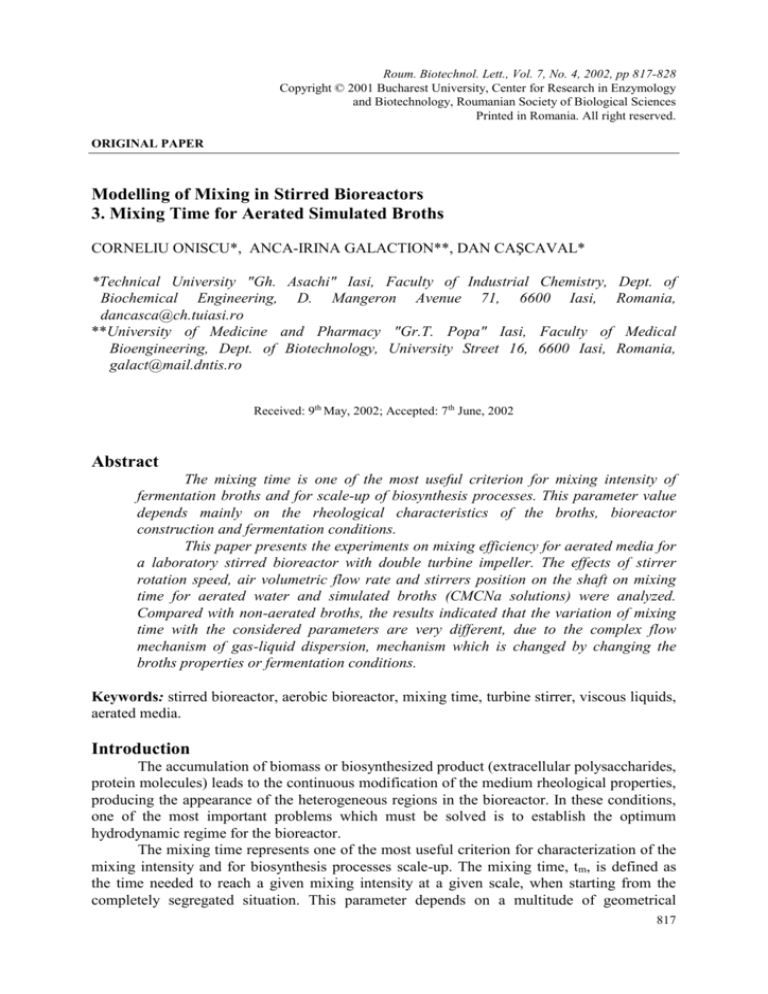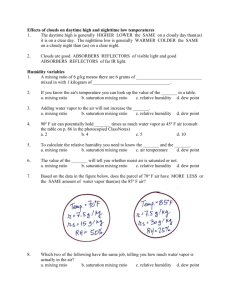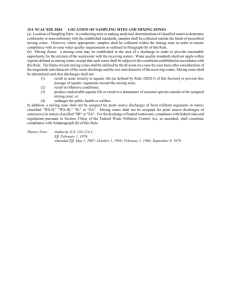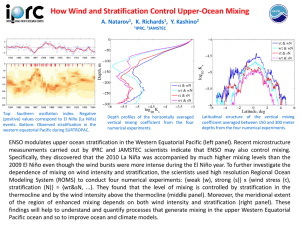
Roum. Biotechnol. Lett., Vol. 7, No. 4, 2002, pp 817-828
Copyright © 2001 Bucharest University, Center for Research in Enzymology
and Biotechnology, Roumanian Society of Biological Sciences
Printed in Romania. All right reserved.
ORIGINAL PAPER
Modelling of Mixing in Stirred Bioreactors
3. Mixing Time for Aerated Simulated Broths
CORNELIU ONISCU*, ANCA-IRINA GALACTION**, DAN CAŞCAVAL*
*Technical University "Gh. Asachi" Iasi, Faculty of Industrial Chemistry, Dept. of
Biochemical Engineering, D. Mangeron Avenue 71, 6600 Iasi, Romania,
dancasca@ch.tuiasi.ro
**University of Medicine and Pharmacy "Gr.T. Popa" Iasi, Faculty of Medical
Bioengineering, Dept. of Biotechnology, University Street 16, 6600 Iasi, Romania,
galact@mail.dntis.ro
Received: 9th May, 2002; Accepted: 7th June, 2002
Abstract
The mixing time is one of the most useful criterion for mixing intensity of
fermentation broths and for scale-up of biosynthesis processes. This parameter value
depends mainly on the rheological characteristics of the broths, bioreactor
construction and fermentation conditions.
This paper presents the experiments on mixing efficiency for aerated media for
a laboratory stirred bioreactor with double turbine impeller. The effects of stirrer
rotation speed, air volumetric flow rate and stirrers position on the shaft on mixing
time for aerated water and simulated broths (CMCNa solutions) were analyzed.
Compared with non-aerated broths, the results indicated that the variation of mixing
time with the considered parameters are very different, due to the complex flow
mechanism of gas-liquid dispersion, mechanism which is changed by changing the
broths properties or fermentation conditions.
Keywords: stirred bioreactor, aerobic bioreactor, mixing time, turbine stirrer, viscous liquids,
aerated media.
Introduction
The accumulation of biomass or biosynthesized product (extracellular polysaccharides,
protein molecules) leads to the continuous modification of the medium rheological properties,
producing the appearance of the heterogeneous regions in the bioreactor. In these conditions,
one of the most important problems which must be solved is to establish the optimum
hydrodynamic regime for the bioreactor.
The mixing time represents one of the most useful criterion for characterization of the
mixing intensity and for biosynthesis processes scale-up. The mixing time, tm, is defined as
the time needed to reach a given mixing intensity at a given scale, when starting from the
completely segregated situation. This parameter depends on a multitude of geometrical
817
CORNELIU ONISCU, ANCA-IRINA GALACTION, DAN CAŞCAVAL
(dimensions of mixing system, dimensions of bioreactor) and technological factors
(fermentation conditions, physical characteristics of the medium, power consumption,
dissipated energy), the general correlation that describes the mixing time being of the
following type:
t m f d / D, N, , , Va / V, P / Pa , T
(1)
The experimental measurement of mixing time uses the tracers (acidic, alkaline or
salts solutions, heated solutions, colored solutions) which are added to the beforehand
homogenized broths. The mixing time is time needed for the considered parameter M (pHvalue, temperature, absorption) not to exceed the considered range M 0.5xM [5]. For
example, an alkaline pulse is added to the liquid, this method being used in this paper
experiments. The system can be regarded as completely segregated at t = 0. After a certain
time, which is the mixing time, the pH remains into the considered range of deviation from
ideally mixed. In this way, the mixing time can be related to the mixing intensity.
For calculation of mixing time, numerous equations have been proposed in literature,
these equations taking into account the type of fermentation (aerobe or non-aerobe), the
rheological characteristics of the broths and the fermentation conditions 1-13. Because of the
complexity of rheological behavior of broths, of the flow phenomena and of the particularities
of fermentation systems, the accuracy of the proposed models is very limited, especially for
aerated broths. Furthermore, the most of these models can predict the mixing time values for
Re > 10,000, this flow regime being rarely reached in the large-scale bioreactors due to the
microorganisms sensitivity to shear stress. For Re < 10,000, these models need some
corrections 6.
For these reasons, the aim of our experiments is to analyze the dependence between
the mixing time, the rheological characteristics of broths, the fermentation conditions and the
biomass concentration, for a stirred bioreactor. For emphasizing and quantifying the effects of
the biomass presence in medium, the studies were carried out with simulated and real broths.
The previous results obtained for simulated broths indicated that, for water or liquids
with low viscosity, the distance between the stirrers assembled on the shaft has to take into
account the interference of the stirrers flow lines, and, for viscous liquids, the position of the
stagnant region in the bioreactor [14]. The presence of biomass in fermentation broths
considerably reduces the mixing efficiency, even at low viscosity level of the suspensions.
The magnitude of this effect depends on the nature, concentration and morphology of
biomass. The experimental studies concerning the mixing of bacteria (Propionibacterium
shermanii), yeasts (Saccharomyces cerevisiae) and fungus (Penicillium chrysogenum, free
mycelia and mycelial aggregates or pellets) non-aerated suspensions in a stirred bioreactor
provided with double impeller emphasized that the value of mixing time increases as follows:
bacteria < yeasts << fungus pellets < fungus free mycelia.
Due to their higher viscosity and pronounced non-Newtonian behavior, the mixing
time for fungus suspensions was significant higher than for bacteria and yeasts suspensions, at
same biomass concentration and operational conditions. Furthermore, the mixing time for free
mycelia suspensions was about 2 - 3 times greater than for mycelial aggregates, owing to the
higher viscosity. But, the mycelial aggregates exhibit an accentuated tendency of solid-liquid
separation, the influence of distance between the stirrers being more important in this case.
Generally, contrarily to the mixing of simulated broths without biomass, for increasing the
mixing efficiency of biomass suspensions, the stirrers have to be placed near the bottom of the
vessel for avoiding the solid phase deposition [15, 16].
By means of the experimental data, for each of the non-aerated systems were
established mathematical correlations which describe unitary the dependence between the
818
Roum. Biotechnol. Lett., Vol. 7, No. 4, 817-828 (2002)
Modelling of Mixing in Stirred Bioreactors 3. Mixing Time for Aerated Simulated Broths
mixing time and apparent viscosity or biomass concentration, stirrer rotation speed and
distance between the stirrers [15].
Because the previous results are adequate only for non-aerated broths, these studies
have been developed for aerated simulated and real broths, at similar experimental conditions.
In this paper are presented the experimental results for simulated broths consisted of
carboxymethylcellulose sodium salt of different viscosities. The obtained data allow to
correlate the mixing time with the geometrical and functional characteristics of the stirred
bioreactor.
Materials and Methods
The experiments were carried out in 5 l (4 l working volume, ellipsoidal bottom)
laboratory bioreactor (Biostat A, B. Braun Biotech International), with computer-controlled
and recorded parameters. The bioreactor mixing system consists of two turbine stirrers and
three baffles. The bioreactor and impeller characteristics are given in Table 1.
Table 1. Characteristics of bioreactor and impeller.
d,
mm
d/D
H/D
w/d
l/d
h/d
No.
blades
No.
baffles
s/d
d’/d
l’/d
64
0.36
1.15
0.12
0.28
1
6
3
0.20
0.21
2.81
The upper stirrer was placed on the shaft at a distance varying between 32 and 128 mm
(0.5d and 2d) from the lower one. The rotation speed was maintained between 0 and 700 rpm.
The experiments were carried out for a Reynolds number intervals below 6,000, which
correspond to the laminar and transitory flow, and avoid the “cave” formation at the broths
surface (for rotation speed over 800 rpm and L = 2d).
The sparging system consists of a single ring sparger with 64 mm diameter, placed at
15 mm from the vessel bottom, having 14 holes with 1 mm diameter. The air volumetric flow
rate was varied from 0 to 400 l.h-1.
In the experiments, water and simulated fermentation broths have been used. The
simulated broths consisted of carboxymethylcellulose sodium salt (CMCNa) having the
apparent viscosity in the domain of 8.25 – 268.7 cP.
Owing to the difficulty of in-situ measurement of viscosity during the experiments, the
viscosity was measured before and after each experiment using a viscometer of Ostwald type.
Both the experiments and viscosity measurements were carried out at a temperature of 21oC.
For determining the mixing time values the following homogeneity criteria for mixing
was considered [6]:
I
pH 0.5pH
x100 99%
pH
(2)
where pH = 0.02.
The values of mixing time have been determined by means of a solution of 2N KOH
as tracer, by recording the time needed to the medium pH-value to reach the value
corresponding to the considered mixing intensity. The tracer volume was of 0.5 ml, the tracer
being injected opposite to the pH electrode, at 10 mm from the liquid surface. The pH
electrode was placed at 20 mm from the vessel bottom. Because the tracer solution density is
close to the liquid phase density, the tracer solution flow follows the liquid flow streams and
there are no errors due to tracer buoyancy. The pH variations were recorded by bioreactor
Roum. Biotechnol. Lett., Vol. 7, No. 4, 817-828 (2002)
819
CORNELIU ONISCU, ANCA-IRINA GALACTION, DAN CAŞCAVAL
computer-recorded system. Each experiment has been carried out three or four times, for
identical conditions, the average value of mixing time being used. The maximum
experimental error was of 3.2%.
Results and Discussions
For an aerobic bioreactor provided with one ore more stirrers the flow mechanism is
complicated due to the combined action of mechanical and pneumatic mixing. Compared with
the non-aerated systems, different flow patterns can exist when gas is sparged into the broth
Generally, the analyze of mixing efficiency for aerated mechanical stirred systems is
derived from that of non-aerated systems, due to the less complicated flow phenomena for the
second ones. In this case, it was assumed that the gas phase does not influence the flow of
liquid phase in stirred vessels [7]. But, the values of mixing time for aerated broths calculated
by means of the equations established for non-aerated systems are lower to the experimental
ones for about 1.2 – 2 times [17].
The influence of aeration on mixing efficiency is much more complex and has to be
distinctly analyzed. For numerous fermentations, owing to the decrease in pumping capacity
of the stirrer, due to the cavity formation, and to the compartmentalization in regions around
each of the stirrers, the aeration increases the mixing time compared with non-aerated
systems. However, as it was affirmed in literature, the deviations from the values obtained for
non-aerated broths depend on the constructive and functional characteristics of the bioreactor.
Thus, the influence of number and position of the stirrers on the shaft is unknown, and the
influence of the gas flow rate is different for different rotation speed or Reynolds number
values [7].
In this context, the aim of this paper is the study of the effects of stirrer rotation speed,
air flow rate and stirrers position on the shaft on mixing time for aerated water and simulated
broths having different viscosities.
1. Influence of stirrer rotation speed
Contrarily to the non-aerated media, for which the mixing time is reduced by
increasing the rotation speed value, for aerated broths the influence of this parameter is
different and must be related to the apparent viscosity, air flow rate and distance between the
stirrers placed on the shaft.
For water, the mixing time initially decreases with the rotation speed, reaches a
minimum value for 100 rpm increasing then, for all considered air flow rates or distances
between the stirrers (Figure 1.a). This evolution could be the result of the modification of
mixing mechanism with the increase of rotation speed in presence of bubbles. Thus, at low
rotation speed, the contribution of pneumatic mixing is considerable, the increase of rotation
speed supplementary intensifying the broth circulation into the bioreactor. At higher rotation
speed, the bubbles retention time increases, the gas-liquid dispersion flow becomes complex
and its circulation velocity is lower than that of the flow streams created by mechanical
mixing in non-aerated media. The value of the rotation speed which corresponds to the
minimum of mixing time is called critical rotation speed [18].
The increase of the liquid phase apparent viscosity or the modification of fermentation
conditions can lead to the change of the variation of mixing efficiency with rotation speed. As
it can observed from Figures 1.b, c and 2.a-c, indifferent of the broth apparent viscosity, by
increasing the stirrer rotation speed the mixing time reaches a minimum value for most of the
studied systems.
820
Roum. Biotechnol. Lett., Vol. 7, No. 4, 817-828 (2002)
Modelling of Mixing in Stirred Bioreactors 3. Mixing Time for Aerated Simulated Broths
a
27
36
L
L
0.5 d
d
1.5 d
2d
32
0.5 d
d
1.5 d
2d
24
21
28
tm, s
tm
18
24
20
15
12
16
9
-1
80 l.h
0
25
-1
300 l.h
0
50 75 100 125 150 175 200
Rotation speed, rpm
25
50
75 100 125 150 175 200
Rotation speed, rpm
b
36
36
L
0.5 d
d
1.5 d
2d
32
0.5 d
d
1.5 d
2d
33
28
30
24
tm, s
tm, s
L
20
27
24
16
-1
150 l.h
100
200
300
400
-1
400 l.h
21
500
100
Rotation speed, rpm
200
300
400
500
Rotation speed, rpm
c
90
L
40
0.5 d
d
1.5 d
2d
36
0.5 d
d
1.5 d
2d
75
32
60
28
tm, s
tm, s
L
24
45
30
20
-1
150 l.h
16
100
200
300
400
15
500
-1
400 l.h
100
Rotation speed, rpm
Figure 1. Influence of rotation speed on mixing time value (a - = 1 cP,
Roum. Biotechnol. Lett., Vol. 7, No. 4, 817-828 (2002)
200
300
400
500
Rotation speed, rpm
b - a = 8.25 cP, c - a = 31.9 cP).
821
CORNELIU ONISCU, ANCA-IRINA GALACTION, DAN CAŞCAVAL
a
L
70
75
L
0.5 d
d
1.5 d
2d
60
0.5 d
d
1.5
2d
60
tm, s
tm, s
50
40
45
30
30
20
15
-1
-1
400 l.h
150 l.h
300
400
500
600
700
300
Rotation speed, rpm
400
500
600
700
Rotation speed, rpm
b
105
90
L
0.5 d
d
1.5
2d
90
L
75
60
60
tm, s
tm, s
75
0.5 d
d
1.5 d
2d
45
45
30
30
15
-1
150 l.h
15
300
400
500
600
-1
400 l.h
300
700
400
500
600
700
Rotation speed, rpm
Rotation speed, rpm
c
120
0.5 d
d
1.5
2d
105
90
L
0.5 d
d
1.5
2d
75
60
75
tm, s
tm, s
90
L
60
45
30
45
30
300
400
-1
400 l.h
15
-1
150 l.h
500
600
Rotation speed, rpm
700
300
400
500
600
700
Rotation speed, rpm
Figure 2. Influence of rotation speed on mixing time value (a - a = 98.5 cP, b - a = 187.3 cP,
c - a = 268.7 cP).
822
Roum. Biotechnol. Lett., Vol. 7, No. 4, 817-828 (2002)
Modelling of Mixing in Stirred Bioreactors 3. Mixing Time for Aerated Simulated Broths
But, the value of critical rotation speed depends on the apparent viscosity and air flow
rate. Therefore, with the increase of apparent viscosity from 8.25 to 268.7 cP, the value of
critical rotation speed increases from 300 to 500 rpm, for air flow rate between 80 and 400 l.h1
, or between 200 and 600 rpm, for air flow rate over 400 l.h-1. As it was earlier mentioned,
this variation is the result of the change in broth circulation into bioreactor, as a consequence
of the increase in gas hold-up, and in a less intensive mixing, respectively. Thus, for an
apparent viscosity of 98.5 cP and 300 rpm, the gas volumetric ratio was of 2.6-3%, becoming
11-12% for 700 rpm.
Although this variation of mixing time is characteristic for most of the considered
systems, it can be modified function of the stirrers position on the shaft and aeration rate.
2. Influence of air volumetric flow rate
The aeration influence on mixing intensity strongly depends on the apparent viscosity
of liquid phase. For water and liquids with close viscosity, the mixing time continuously
decreases with air flow rate, the magnitude of this effect being function of rotation speed
value (Figure 3.a).
This variation of mixing efficiency with aeration rate is considerably changed for
viscous media. Up to about 10 cP the coalescence characteristics of the liquid phase are
modified, this determining the change in bubbles circulation velocity, bubbles dispersion and
hold-up compared with non-aerated media [19]. Thus, at lower aeration rate, with the increase
of viscosity bubbles coalescence increases, very large bubbles are formed, which can reach 80
mm diameter for a distance of 0.5d between the stirrers. In this circumstances, it were
observed the heterogeneous distribution of air in the liquid phase, the reduce of air hold-up
and the rise of bubbles through preferential central routes, this resulting in higher values of
mixing time. The increase of air flow rate leads to the intensification of gas-liquid dispersion
circulation, therefore to the decrease of mixing time which reaches o minimum value (Figures
3.b, c and 4.a-c). The value of air volumetric flow that corresponds to the minimum of
mixing time, called critical flow rate, depends on liquid apparent viscosity, rotation speed and
stirrers position on the shaft. Thus, for most of the studied systems, the mixing time minimum
value was reached for a critical flow rate of 150 – 200 l.h-1. But, for apparent viscosities lower
than 100 cP, the increase of rotation speed can lead to the modification of the critical flow rate
to higher values (250 – 300 l.h-1 for rotation speed values over 300 rpm).
For constant rotation speed value, the supplementary increase of aeration rate induces
the increase of mixing time. This variation is the result of the formation of smaller bubbles
having lower rise velocity, thus leading to the increase in gas hold-up value and to the
decrease of dispersion circulation velocity. The phenomena was more evidently observed for
the experimental conditions for which the mechanical agitation exhibits a significant role in
dispersion and retention of bubbles in media.
At higher air flow rate values, the mixing time reaches a maximum, reducing then. The
maximum value corresponds to the flooding point, when the energy dissipated by the air
exceeds that of the stirrer. At this moment, the rise velocity of the air increases, determining
the simultaneous increase in the intensity of media circulation. The existence of the maximum
value of mixing time, respectively of the flooding phenomena, is specific to some different
rotation speed domains controlled by the apparent viscosity. Thus, the maximum was reached
at rotation speed values below 200 rpm for an apparent viscosity lower than 31.9 cP, at
rotation speed below 400 rpm for apparent viscosity between 31.9 and 98.5 cP, and at rotation
speed below 600 rpm for higher apparent viscosities. The flooding aeration rate was of
300 l.h-1.
Roum. Biotechnol. Lett., Vol. 7, No. 4, 817-828 (2002)
823
CORNELIU ONISCU, ANCA-IRINA GALACTION, DAN CAŞCAVAL
a
36
28
L
26
24
32
0.5 d
d
1.5 d
2d
28
22
tm, s
tm, s
L
0.5 d
d
1.5 d
2d
20
24
18
20
16
50 rpm
200 rpm
16
14
100
150
200
250
100
300
Air volumetric flow rate, l.h
-1
150
200
250
300
Air volumetric flow rate, l.h
-1
b
L
45
36
0.5 d
d
1.5 d
2d
40
0.5 d
d
1.5 d
2d
33
30
tm, s
35
tm, s
L
30
27
24
25
20
21
100 rpm
100
150
200
250
300
500 rpm
350
Air volumetric flow rate, l.h
18
400
100
-1
150
200
250
300
350
Air volumetric flow rate, l.h
400
-1
c
160
0.5 d
d
1.5 d
2d
140
120
L
40
0.5 d
d
1.5 d
2d
35
100
30
tm, s
tm, s
45
L
80
60
25
20
40
15
100 rpm
500 rpm
20
100
150
200
250
300
350
Air volumetric flow rate, l.h
400
100
150
200
250
300
350
-1
Air volumetric flow rate, l.h
400
-1
Figure 3. Influence of air volumetric flow rate on mixing time value (a - = 1 cP, b - a = 8.25 cP,
c - a = 31.9 cP).
824
Roum. Biotechnol. Lett., Vol. 7, No. 4, 817-828 (2002)
Modelling of Mixing in Stirred Bioreactors 3. Mixing Time for Aerated Simulated Broths
a
80
L
90
0.5 d
d
1.5
2d
80
0.5 d
d
1.5 d
2d
60
70
50
tm, s
tm, s
L
70
60
40
30
50
20
40
300 rpm
100
10
150 200 250 300 350
-1
Air volumetric flow rate, l.h
700 rpm
100
400
150 200 250 300 350
-1
Air volumetric flow rate, l.h
400
b
90
0.5 d
d
1.5 d
2d
L
0.5 d
d
1.5 d
2d
80
70
60
tm, s
tm, s
L
120
110
100
90
80
70
60
50
40
30
50
40
30
20
300 rpm
100
150
200
250
300
700 rpm
10
350
Air volumetric flow rate, l.h
100
400
-1
150
200
250
300
350
Air volumetric flow rate, l.h
400
-1
c
105
L
150
0.5 d
d
1.5 d
2d
135
0.5 d
d
1.5 d
2d
90
120
75
tm, s
105
tm, s
L
90
60
75
45
60
30
45
300 rpm
100
150
200
250
300
700 rpm
15
30
350
Air volumetric flow rate, l.h
400
-1
100
150
200
250
300
350
Air volumetric flow rate, l.h
400
-1
Figure 4. Influence of air volumetric flow rate on mixing time value (a - a = 98.5 cP, b - a = 187.3 cP,
c - a = 268.7 cP).
Roum. Biotechnol. Lett., Vol. 7, No. 4, 817-828 (2002)
825
CORNELIU ONISCU, ANCA-IRINA GALACTION, DAN CAŞCAVAL
On the other hand, as it can be observed from Figures 3 and 4, the mixing time either
continuously increases with air flow rate after reaching its minimum value, for rotation speed
greater than 200 rpm and apparent viscosity below 31.9 cP, or decreases for entire considered
aeration domain, for rotation speed greater than 400 rpm and apparent viscosity between 31.9
and 98.5 cP. The observed variation of mixing intensity indicated that in the first case the
flooding is avoided at higher rotation speed, and the aeration contributes positively at mixing,
in the second one.
3. Influence of distance between the stirrers
Excepting water, for which the variation of mixing time with rotation speed or aeration
rate is similar for all positions of the stirrers on the shaft, the distance between the stirrers can
modify the evolution of mixing time with the considered parameters.
In the previous works was stated that for non-aerated water the minimum values of
mixing time are reached for a distance between the stirrers of 1.5d [14,15]. As it can be seen
from Figures 3.a, the lowest values of mixing time for aerated water are obtained for a
distance of 0.5d - d, as the result of a more homogeneous distribution of bubbles in liquid
phase, especially at higher rotation speed level. Contrarily to the non-aerated CMCNa
solutions, for which a distance of 2d leads to the minimum mixing time, for the most of
studied aerated viscous solutions the minimum was reached for 0.5d, too. But, from Figures
2.a-c it can observed that for the apparent viscosities over 31.9 cP the variation of mixing time
with rotation speed for 0.5d completely differs compared with the others positions of the
stirrers on the shaft. Thus, for the entire domain of aeration rate level and a distance of 0.5d
the mixing efficiency continuously increases with stirrer rotation speed. For viscous liquids,
this evolution is explained by the tendency of bubbles accumulation and coalescence in the
region around the stirrer, phenomena that is more pronounced for lower distance between the
stirrers. As it was earlier mentioned, the accumulation of air around the stirrer reduces the
dispersion circulation velocity. By increasing the rotation speed, the very large bubbles
formed in the stirrer region are dispersed and uniformly distributed in liquid phase. The rise
velocity of the bubbles in the upper compartment of the bioreactor is higher if the stirrers are
closely placed on the shaft.
The highest values of mixing time were obtained for a distance of 1.5d for water, and
d for viscous simulated broths, as the effect of the compartmentalization of flow regions and
increase of retention time of bubbles in the liquid phase, both reducing the dispersion
circulation velocity.
Conclusions
The flow mechanisms of aerated and non-aerated are very different, this being the
result of a different influence of stirrer rotation speed and construction and air volumetric flow
rate on mixing time.
For water and simulated viscous media the increase of rotation speed value leads to the
decrease of mixing time, which reaches a minimum value, corresponding to the critical
rotation speed, increasing then. The value of critical rotation speed depends on aeration rate
and varies between 300 and 500 rpm, for air flow rate between 80 and 400 l.h-1, or between
200 and 600 rpm, for air flow rate over 400 l.h-1.
In most of the studied systems, the variation of mixing time with gas flow rate
indicates a sinusoidal dependence. Thus, with increasing the aeration rate the mixing initially
decreases, reaches a minimum value, and increases to a maximum value. For lower rotation
826
Roum. Biotechnol. Lett., Vol. 7, No. 4, 817-828 (2002)
Modelling of Mixing in Stirred Bioreactors 3. Mixing Time for Aerated Simulated Broths
speed or higher apparent viscosity values, the mixing time decreases then by supplementary
increase of aeration rate.
The lowest values of mixing time for aerated water are obtained for a distance of 0.5d
– d between the stirrers placed on the shaft, and 0.5d for CMCNa solutions, as the result of a
more homogeneous distribution of bubbles in liquid phase. Furthermore, the variation of
mixing efficiency with aeration rate or rotation speed for a distance of 0.5d is completely
different those obtained from the other positions of the stirrers, the mixing efficiency
continuously increasing with stirrer rotation speed.
The observed phenomena are the results of change of pumping capacity of the stirrer,
due to the cavity formation, compartmentalization in regions around each of the stirrers,
coalescence and dispersion of bubbles and flooding. These lead to a very complex flow
mechanism of the gas-liquid dispersion, mechanism which is changed by changing the broths
properties or fermentation conditions.
Notations
d - stirrer diameter
d’ - pH electrod diameter
D - bioreactor diameter
h - distance from the inferior stirrer to the bioreactor bottom
H - bioreactor height
l
- impeller blade length
l’ - pH electrode immersed length
L - distance between the stirrers
N - impeller rotation speed
P - power consumption for mixing of non-aerated broths
Pa - power consumption for mixing of aerated broths
pH - value of pH at t =
pH - allowed deviation from ideally mixed
s - baffle width
tm - mixing time
Va - volumetric air flow rate
V - volume of medium
T - energy dissipated
a - apparent viscosity
- density
References
1. C.J. HOOGENDOORN, A.P. DEN HARTOG, Chem. Eng. Sci., 22, 1689 (1967).
2. Y.T. SHAH, G.J. STIEGEL, M.M. SHARMA, A. I. Ch. E. J., 24, 369 (1978).
3. A. EINSELE, Proc. Biotechnol., 7, 13 ( 1978).
4. R. MANFREDINI, V. CAVALLERA, L. MARINI, G. DONATI, Biotechnol. Bioeng., 25,
3115 (1983).
5. J.J. HEIJNEN, K. VAN’T RIET, Chem. Eng. J., 28, B21 (1984).
6. P. VERLAAN, J. TRAMPER, K. VAN’T RIET, CH.K.A.M. LUYBEN, Chem. Eng. J.,
33, B43 (1986).
827
Roum. Biotechnol. Lett., Vol. 7, No. 4, 817-828 (2002)
CORNELIU ONISCU, ANCA-IRINA GALACTION, DAN CAŞCAVAL
7. K. VAN’T RIET, J. TRAMPER, Basic Bioreactor Design, M. Dekker Inc., New York, pp.
183 (1991).
8. H.-J. REHM, G. REED (Eds.), Biotechnology, vol.4, VCH, Weinheim, pp. 299 (1991).
9. B. MAYR, P. HORVATH, E. NAGY, A. MOSER, Biotechnol. Bioeng., 43, 195 (1994).
10. A.G. PEDERSEN, M. BUNDEGARD-NIELSEN, J. NIELSEN, J. VILLADSEN,
Biotechnol. Bioeng., 44, 1013 (1994).
11. A.W. NIENOW, Trans. I. Chem. E., A74, 417 (1996).
12. R. POHORECKI (Ed.), Fluid Mechanics Problems in Biotechnology, 51, 3 (1998).
13. A. LUBBERT, S.B. JORGENSEN, J. Biotechnol., 85, 187 (2001).
14. C. ONISCU, A.I. GALACTION, D. CASCAVAL, F. UNGUREANU, Roum. Biotechnol.
Lett., 6, 43 (2001).
15. D. CASCAVAL, C. ONISCU, A.I. GALACTION, F. UNGUREANU, Chem. Industry J.,
55, 367 (2001).
16. C. ONISCU, A.I. GALACTION, D. CASCAVAL, F. UNGUREANU, Biochem. Eng. J.
(in press).
17. A. EINSELE, R.K. FINN, Ind. Eng. Chem. Proc. Des. Dev., 19, 600 (1980).
18. D. CASCAVAL, C. ONISCU, A.I. GALACTION, Inginerie biochimica si
biotehnologie.2. Bioreactoare, InterGlobal, Iasi (2002).
19. J.J.HEIJNEN, K. VAN’T RIET, D.J. WOLTHUIS, Biotechnol. Bioeng., 22, 1945 (1980).
828
Roum. Biotechnol. Lett., Vol. 7, No. 4, 817-828 (2002)







